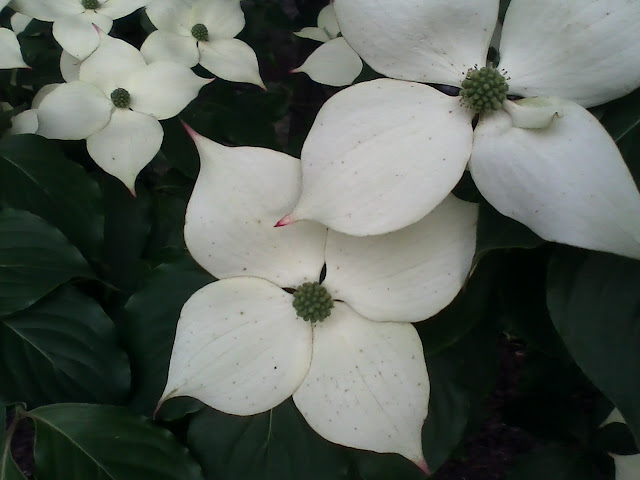 |
| Blossoms of the Kousa Dogwood |
 |
| one of the new trees |
A couple weeks ago my husband came home with a big smile on his face and said he had a surprise in the back of the pick up truck! I, hesitantly, went out to see what he'd brought home this time--if it was a good surprise or a not so good one. And it was a good one--bargain trees from a farm he had come across somewhere nearby. For a fraction of what they should have cost and would have cost someplace else, he had snagged us 4 small trees which he thought were Dogwood and he planned to plant them just beyond the fence that separates our back yard into 2 sections.
Once we got them into place, I took a closer look at the leaves and realized they didn't quite look like the 2 old Dogwood trees we have, though similar; They do however look just like another very pretty tree we have at the front corner of the house, which I never was able to identify--until now.
I started researching and found out the name of our mystery tree and our new bargain trees is the Kousa Dogwood or Japanese Flowering Dogwood.
 |
| foliage & small blossom on new tree |
The Kousa/Japanese Dogwood is described as a small ornamental tree with appeal for all four seasons with its darker green foliage, long lasting showy flowers, multi-trunked low branching shape and interesting decorative bark.
Leaves: a medium to dark green, broad elliptic, opposite, fall color ranges from reddish purple to green or chartreuce.
Flowers: the true flowers are ornamentally insignificant and are small yellowish green, centered in what most people see as the "flower" which are actually 4 showy bracts beginning small and lime colored and then expanding to bold white. Blooms in June for 4-6 weeks.
Fruits: globular, resembling large raspberries, green turning to pink then dull red in fall, readily eaten by birds and squirrels when ripe.
Trunk/Bark: multi-trunk or single trunk with very low branching, slender twigs, light brown-grey bark interrupted by yellow-beige or dark grey-white blotches more prominent with age.
Other notes: slow growth rate, maturing to 20 feet tall 20 feet wide, full sun to partial shade, no serious disease or pest problems, more adaptable to alkaline soils and dry soil than its more popular counterpart Flowering Dogwood, upright vased growth style in youth but horizontally layered branching as it ages. Particularly good for a focal point, entryway, border, or seasonal accent plant. Usually available in ball, burlap, or container form. Propagated by rooted cuttings.
In summary, these trees were a very good bargain find, and a lovely addition to our yard/gardens which we will be able to enjoy even more as they mature. Also, they look especially nice at night with the accent of a solar spot light set close to the trunk and pointed upward into the branches.

Such a lovely story! Bryan always finds such great deals! Pretty Pretty!
ReplyDelete